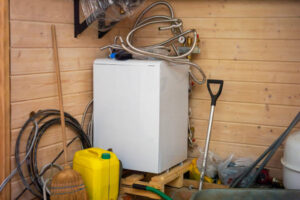Decks are an important part of any home’s exterior. They provide a place for homeowners to relax and spend time with their family and friends. The deck can also be used for cooking and entertaining all year round. A deck on the exterior of a house can also increase its value when it is sold.
Decks need to be maintained regularly in order to retain their aesthetic appeal and functionality. Decks that are not properly maintained can quickly deteriorate and lose their value.
Staining your deck will help you avoid this.
What is Deck Staining?
The process of staining involves adding a protective coat or layer to the deck. Oil-based stains can also be used. Most stains are water-based. The coating helps protect the deck against the UV rays of the sun and maintains its natural color. The coating also protects the deck against mildew and algae.
Why Stain A Deck
A deck stain for the exterior of your home is an investment that will enhance its aesthetics and value. It is usually cheaper to stain a deck than replace the wood or other materials. This will help you to preserve the original appearance of your home. It also adds charm and character to an old space.
There are many reasons why homeowners stain their decks.
The staining process adds an extra layer of protection to the wood beneath, protecting it from damage caused by rain, snow, and ice.
The stain also helps prevent the growth of mold, mildew, and fungus on the deck surface. These growths may cause splinters or even damage the wood structure.
The stain provides a protective layer against foot traffic on the deck.
Stains will keep your deck looking new and clean.
How To Choose A Deck Stain
When choosing the exterior deck stain for your home, there are a few factors that you should take into consideration. Here are six suggestions for selecting the best deck stain.
Take Into Consideration The Type Of Wood
Consider the type of wood you will be staining first. The best way to start your research is to contact a professional. Professional contractors can assist homeowners in determining which deck stains will work best for their home’s wood type.
Different types of wood need other kinds of stains. Each type of hardwood has its requirements for nutrients and levels of moisture.
Cedar and Redwood
Decks made from cedar and redwood can be susceptible to changes in temperature or moisture. Natural tannins in cedars and redwoods help protect wood from fungus growth. Water-based stains should not be used on these decks, as they will trap moisture. Instead, they should use oil-based or deck stains specially formulated for cedar and redwood decks.
Pine
Decks are commonly made from softwoods, such as pinewood. Pine can turn gray when exposed to water and moisture. To avoid this, use a deck stain that preserves the color of softwood. You should also consider an oil-based deck stain with moisture resistance, as this type of wood is prone to absorb water.
Hardwood
Hardwoods include oak, maple, ash, and ipe. Decks made of these hardwoods are less susceptible to moisture fluctuations than cedar or redwood. They are extremely durable, and they require a stain that emits lower levels of volatile organic compounds (VOCs) to protect them from damage caused by sunlight. Low-VOC exterior stains are usually dry with a matte finish.
Even though hardwood decks are durable, they still need a deck stain that is tough and provides good weather protection. Oil-based stains are recommended for homeowners because they may not offer the same protection from the elements as water-based stains.
Pressure Treated Wood
Homes built on piers and in areas with high humidity are more likely to have pressure-treated decks. Pressure treatment often uses alkaline copper quternary (ACQ), a very corrosive type of wood. Exterior stains must withstand moisture and harsh weather conditions.
Consider The Wood Finish
Before purchasing a product, consider the type of finish used on your deck. Decks are usually finished in one of three ways:
Clear Wood Finish
Clear wood finishes give a delicate and natural look. This finish lets the wood grain show through and allows the wood to shine naturally. Clear exterior deck stains are typically low- or non-VOC with a soft shine.
Dark Wood Finish
Darker woods are less visible and, therefore, require more vibrant stain colors. Dark finishes can be created by adding one or more colors to a base coat.
Painted Wood Finish
Alkyds, which are oil-based, can be used to paint decks instead of staining them with wood stain. Alkyds can last many years without needing to be re-coated.
Consider the Wood’s Condition
Consider the condition of your deck prior to applying a new color. Although this tip seems obvious, many homeowners do not prepare their decks properly for staining because they do not realize that wood must be primed or sanded first. Before applying a new deck finish, it’s important to remove any flaking paint.
Consider Climate Conditions
Before choosing a stain, you should consider the climate of your area. Residents of hotter climates might need exterior stains that are resistant to heat. Even those who do not live in extreme temperatures should look for an exterior stain with UV protection and water repellency to keep their decks looking good despite heavy snowfall or rain.
Many homeowners make the mistake of applying exterior stains in winter. Exterior stains need to be cured for at least 3-4 days before they are exposed to rain or foot traffic. Avoid applying deck stain during rainy or windy weather, as this will cause the product to run and drip. You should, therefore, wait for the perfect weather conditions before starting the staining procedure.
Compare deck stain brands and colors.
When selecting stain colors and brands for your deck, you should compare them. It’s important to compare stain brands and qualities before choosing a product. Some stains can dry quickly, while others may require several days.
The color is another important factor. Select an exterior deck stain to match your decking or paint colors. When selecting an exterior deck stain, it’s recommended that you use a colorant because the natural tone of the wood may not be what you desire. Many homeowners choose a stain color by using paint samples. This is the most accurate way to match the exterior of their home.
Consider Stain Ratings
Check out the stain ratings for different types of deck stains. Some products are rated low because they flake off or peel after application, while others may be rated highly because they provide an exceptionally durable exterior finish.
You don’t want your money spent on a product you’ll need to replace in a few short years. When choosing the right exterior deck finish, look for online reviews by professionals and consumer feedback.
Exterior Deck Stain Types
Before you choose a deck stain, you should be aware of the types available. There are three basic deck stains that homeowners use today.
Oil-Based
Oil-based coatings are made from tung oil or another type of oil. Oil-based stains are highly pigmented, durable, and take a longer time to dry.
Water-Based
These stains can be made with alkyl resins, hydroxyethyl, and acrylics. They are easy to use but wear quickly and require frequent reapplications.
Hybrid
Hybrid stains combine oil-based and aqueous-based coatings. These penetrating coats protect the wood while creating a luster.
Certain types of stains work better in certain environments. Oil-based stains, for example, are the best choice for decks exposed to direct sunlight. They won’t crack or fade, but they can be difficult to maintain and apply.
Water-based stains penetrate deeper into wood than oil-based ones. They dry faster. These stains are easy to use but need to be reapplied every year.
These hybrid stains offer reliable protection from UV rays and rain. They also dry quickly. These products come in a variety of colors and provide a light sheen.
Final Thoughts
Exterior deck stains can be an inexpensive way to maintain your deck’s natural beauty. However, choosing an exterior deck stain can seem difficult, as there are so many different brands and types on the market. However, if you follow the tips above, it will be easy.


